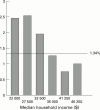Visual impairment and socioeconomic factors
- PMID: 9290372
- PMCID: PMC1722263
- DOI: 10.1136/bjo.81.7.574
Visual impairment and socioeconomic factors
Abstract
Background: Information about socioeconomic factors associated with visual impairment can assist in the design of intervention programmes. Such information was collected by the Melbourne Visual Impairment Project (Melbourne VIP).
Methods: The Melbourne VIP was a population based study of non-institutionalised permanent residents in nine suburbs of the Melbourne metropolitan area aged 40 years of age and older. A standardised eye examination was provided to eligible residents which included a structured interview. Variables of interest for this analysis were age, sex, country of birth, language spoken at home, education level, use of private health insurance, employment status, and living arrangements. Visual impairment was defined as a best corrected visual acuity < 6/18 and/or visual field constriction to within 20 degrees of fixation.
Results: A total of 3271 (83%) residents participated. Participants ranged in age from 40 to 98 years; 54% were female. Forty four (1.34%) were classified as visually impaired due to visual acuity and/or visual field loss. To evaluate the independent association of the significant sociodemographic variables with visual impairment, a regression model was constructed that included age, retirement status, use of private health insurance, and household arrangement. The results showed that age was the significant predictor of visual impairment (OR: 3.19; CI: 2.29-4.43), with the mean age of people with visual impairment significantly older (75.0 years) compared with people without visual impairment (58.2 years) (t test = 9.71; p = 0.0001). Of the 44 visually impaired people, 39 (87%) were aged 60 years of age and older.
Conclusion: The results indicate that age is the most significant factor associated with visual impairment. Of some importance was the finding that people with visual impairment were less likely to have private health insurance. With the aging of the population, the number of people affected by visual impairment will increase significantly. Intervention programmes need to be established before the onset of middle age to offset the escalation of visual impairment in the older population.
Figures
References
Publication types
MeSH terms
LinkOut - more resources
Full Text Sources
Medical

